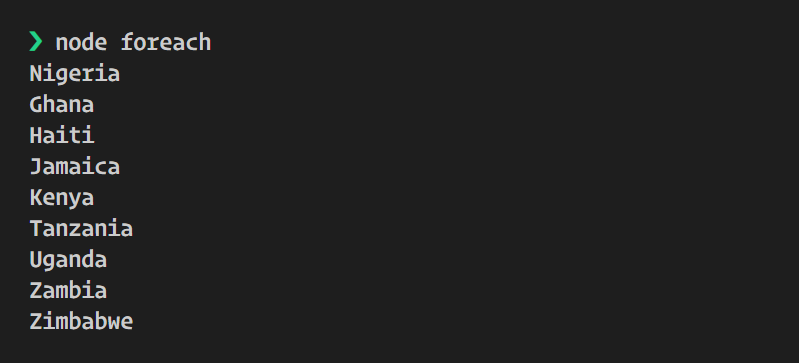This is a step-by-step tutorial with examples showing how to use JavaScript array methods.
Filter array method
const laptop = [
{
model: 'Macbook Pro',
price: 20000,
},
{
model: 'Macbook Air',
price: 15000,
},
{
model: 'Hp lite',
price: 5000,
},
{
model: 'Dell',
price: 400,
},
];
const filteredLaptop = laptop.filter((laptop) => {
return laptop.price > 10000;
});
console.log(filteredLaptop);
Explanation:
1. We are creating a new array called filteredLaptop.
2. We are filtering through the array laptop and checking if the laptop.price is greater than 10000.
3. If so, we are adding the laptop to the filteredLaptop array.
4. We then return filteredLaptop.
Map method
const laptop = [
{
model: 'Macbook Pro',
price: 20000,
},
{
model: 'Macbook Air',
price: 15000,
},
{
model: 'Hp lite',
price: 5000,
},
{
model: 'Dell',
price: 400,
},
];
const getLaptopModel = laptop.map((item) => {
return item.model;
});
console.log(getLaptopModel);
Explanation:
1. We create an array with 3 objects inside.
2. We create an arrow function to map the array and return the property of model.
3. We log the result.
forEach Method
const countries = [
'Nigeria',
'Ghana',
'Haiti',
'Jamaica',
'Kenya',
'Tanzania',
'Uganda',
'Zambia',
'Zimbabwe',
];
//Ex 1
countries.forEach((country, index) => {
console.log(`I am from ${country} and my index is ${index}`);
// foreach does not return anything o
});
Ex2.
countries.forEach((country, index) => {
if (country === 'Zambia') {
console.log(`I am from ${country} and my index is ${index}`);
}
});
Ex3.
countries.forEach((country, index) => {
if (country.length > 7) {
console.log(`${country} character is greater than 7`);
}
});
Ex4.
countries.forEach((country, index) => {
let containedLetters = 'han';
if (country.includes(containedLetters)) {
console.log(`${country} contains the letter ${containedLetters}`);
}
});
Ex5.
countries.forEach((country, index) => {
let containedLetters = 'Nig';
if (country.startsWith(containedLetters)) {
console.log(`${country} Starts with the letter ${containedLetters}`);
}
});
Ex.6
const countries = [
{ name: 'Nigeria', landMass: '3000' },
{ name: 'Ghana', landMass: '787878' },
{ name: 'Haiti', landMass: '293829' },
{ name: 'Jamaica', landMass: '666660' },
{ name: 'Kenya', landMass: '8934' },
{ name: 'Tanzania', landMass: '3434.5' },
{ name: 'Uganda', landMass: '23232' },
{ name: 'Zambia', landMass: '4444' },
{ name: 'Zimbabwe', landMass: '111' },
];
countries.forEach((country, index) => {
console.log(country.name);
Result:

});
Includes Array method
const items = [1, 2, 3, 4, 5, 6];
const includesTwo = items.includes(2);
console.log(includesTwo);
Explanation:
1. In Javascript, the includes method is a method from the Array prototype
2. This method takes an argument and returns true or false depending on whether the argument is in the Array or not
Map array method
const laptop = [
{
model: 'Macbook Pro',
price: 20000,
},
{
model: 'Macbook Air',
price: 15000,
},
{
model: 'Hp lite',
price: 5000,
},
{
model: 'Dell',
price: 400,
},
];
const getLaptopModel = laptop.map((item) => {
return item.model;
});
console.log(getLaptopModel);
Find Array method
//Find array method
const laptop = [
{
model: 'Macbook Pro',
price: 20000,
},
{
model: 'Macbook Air',
price: 15000,
},
{
model: 'Hp lite',
price: 5000,
},
{
model: 'Dell',
price: 400,
},
];
const findLaptop = laptop.find((laptop) => {
return laptop.model === 'Macbook Pro';
});
console.log(findLaptop);
Every array method
const food = [
{
name: 'pizza',
price: 100,
},
{
name: 'burger',
price: 200,
},
{
name: 'pasta',
price: 300,
},
{
name: 'rice',
price: 400,
},
{
name: 'chicken',
price: 500,
},
];
const checkIfFoodHasPriceLessThan200 = food.every((item) => {
return item.price < 200;
});
console.log(checkIfFoodHasPriceLessThan200);
Explanation:
1. food is an array of objects.
2. food.every() is a method on the array.
3. Every() method iterates over each item in the array, and calls the function
passed to it. The function is passed the item, and the index of that item.
If the function returns true, the every() method returns true, otherwise
every() returns false.
4. The function checks if the price of each item is less than 200.
5. checkIfFoodHasPriceLessThan200 is set to true if every item has a price
less than 200, otherwise it returns false.
Some array method
const food = [
{
name: 'pizza',
price: 100,
},
{
name: 'burger',
price: 200,
},
{
name: 'pasta',
price: 300,
},
{
name: 'rice',
price: 400,
},
{
name: 'chicken',
price: 500,
},
];
const checkIfFoodHasPriceLessThan200 = food.some((item) => {
return item.price < 200;
});
console.log(checkIfFoodHasPriceLessThan200);
Result:
Explanation:
1. The code checks if any item in the food array has a price less than 200.
2. The .some() method checks if any of the elements in the food array returns true.
3. The .some() method returns true if any of the elements in the food array return true.
4. The .some() method returns false if all of the elements in the food array return false.
Reduce array method
const food = [
{
name: 'pizza',
price: 100,
},
{
name: 'burger',
price: 200,
},
{
name: 'pasta',
price: 300,
},
{
name: 'rice',
price: 400,
},
{
name: 'chicken',
price: 500,
},
];
const total = food.reduce((currentTotal, item) => {
return item.price + currentTotal;
}, 0);
console.log(total);
Explanation:
1. We are using the reduce function to add up the total price of all the food items in the array.
2. The first argument of the reduce function is the currentTotal.
3. The second argument of the reduce function is the item.
4. We are using the item.price to add the value of item.price to the currentTotal.
5. The currentTotal is set to 0 because we want to start with a base value of 0.
6. The value of currentTotal is returned at the end of the reduce function.
7. The value of the total is logged to the console.
Conclusion
I hope you found this information useful.
Other array methods, along with examples of how you will use them, should be left in the comments section.














Top comments (0)